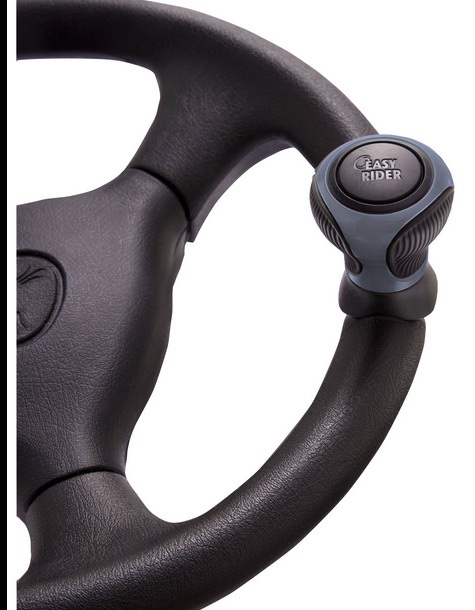That’s pretty cool! We have something like that at our local museum, but it’s not functional. Very neat to see it in action.
[Checks @Reply’s profile] … Yep, he’s young enough to not know this, but old enough to be told now. ![]()
Properly called “Necker knobs”, or so my Dad told me when I was a youngster. Makes it easy for the (male) driver to be way over on the other side of the bench seat of a big 1930 or 1940s car with his (female) passenger entertaining one another while still steering with an outstretched left arm and an occasional glance forward.
Never had one myself, (knob or 1940s car), but the idea is intriguing.
Huh… ![]() oh…
oh… ![]()
![]()
I drove one of these bad boys when I was 7.
That looks fun. How did it work? You’d pull the levers to rotate the back axle?
And won’t your arms get in the way of your pedal legs?
I’ve always heard them referred to as “Suicide Knobs”
I have a friend who in the 80s was obsessed with driving a car using a joystick. Supposedly her dad had converted a car at some point in time, and it was certainly within the dad’s capabilities, but I never got the story. I always imagined using an Atari 2600 joystick, which is just a stick that presses 4 different buttons, and that seemed like a very bad idea.
A variation on twin stick steering is twin stick brake steering. Instead of the sticks directly controlling the speed and direction of the tracks, the sticks are just brake levers for each track. A throttle and transmission control the speed and rotational direction of both tracks, and the brakes are used to slow one or the other track. This is a simpler and cheaper setup than having each track controlled by it’s own hydraulic motor, or something.
Don’t light planes also use brake steering?
Ancient tailskid-equipped airplanes did exclusively. Each main wheel brake was controlled separately by a small pedal near the rudder pedals, or was controlled by an additional axis of motion on the rudder pedals. Stomp left brake and the airplane pivots left.
The next development was a steerable tailwheel connected to the rudder pedals via springs. So you could push a pedal to the floor to move the rudder to the stops but it’s only applying spring pressure to steer the tailwheel the same way. But only through say, ±20 degrees.
The next development was adding a breakaway feature so the tailwheel could break loose of the pedal steering and caster freely, like the front wheels of a shopping cart. So you’d stomp the e.g. left brake hard and the airplane would start to pivot aggressively and the tailwheel would break loose of it’s control yoke and you’d be spinning around your main wheels in a very tight circle. Great for parking. Just pull straight ahead to recenter the tailwheel in the control yoke and it’d reconnect itself.
Then came the big switch to nosewheels. Same idea as the tailwheels minus the breakaway feature. Rudder pedal pressure can turn the nosewheel WAG ±20 degrees. Beyond that, adding differential braking can force a tighter turn. Net of a little tire scrubbing.
Some few production light airplanes, and many homebuilts, have completely free-castering nosewheels where differential braking is the only ground steering there is.
That looks ridiculously fun. I kinda want one.
Back in 1954, Golden Sahara had “automated braking and steering systems. There was even a system that allowed for voice control and a remote that could start, stop, accelerate, and brake the car, making it effectively autonomous.” - The Golden Sahara II Custom Sells for $1,265,000 at 2025 Mecum Auction
Many tractors, while they have steering wheels, can also be steered with the brakes: the (rear) wheels have individual brake pedals. Step on the left one to turn left, the right one to turn right, both together to stop.
Many farmers get in the habit of turning around a field in the same direction; which wears down the brakes differently. So when you step on both together in order to stop, you need to remember that the tractor may also turn. Not a good idea for a vehicle driven at speed in traffic; but useful for making tight turns at slow speed in a field.
A horizonal bar in front of you at steering wheel height. It would control like a hang glider- push forward to go forward, and move it side to side to steer.
Similarly, in the 1960s Mercury tried out setup with two wheels you controlled with your wrists rather than a traditional steering wheel.
With modern technology, automobile controls can get increasingly abstracted. Ultimately, you could have a car whose controls consist of entering a destination (verbally, by keyboard, or by tapping a spot on a map), and then the onboard computer handles all of the actuators to make the car actually steer.
Even short of that, with a computer in between the driver and the actuators, there are any number of other options: Like, you could have a Kinect-style camera watching the driver, so they can steer via gestures (and precisely what gestures are used could even be customized by the driver).
I had one of these when I was a kid in the late 60’s
I’ve always played driving/racing games with a joystick. Tried a wheel & pedals once but didn’t get on with it.
Or by brain-computer interface.
And that reminds me, some of the very early horseless carriages used a simple tiller for steering rather than a steering wheel.


